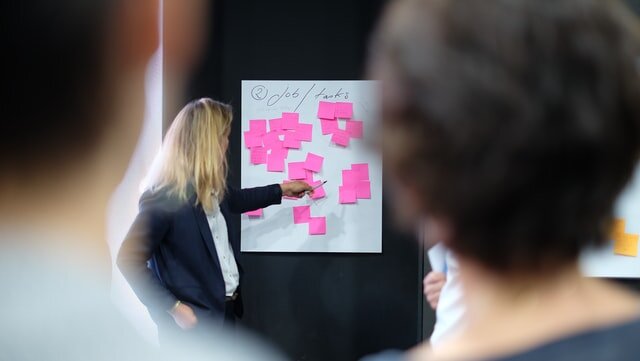Open Innovation & Ideation Powered by Blockchain
A chain of ideas ‘written in stone’ on blockchain — in the context of Open Innovation. A global platform for publishing ideas, empowering collaboration, and contribution; powered by distributed ledger technology.
Great ideas energize and inspire people; they can transform teams, products, companies, or even societies; they can bring fresh views to complex problems; they can reshape strategies and shed light on unexplored areas.
Yes, ideas alone cannot change the world or build business empires. In practice, even the boldest of ideas can be forgotten, abandoned, or fail due to poor framing and/or execution. To drive results and bring impact, great ideas also need exceptional execution which usually involves a massive effort and collaboration across various teams and, in some cases, organizations.
However, every initiative starts with ideas. It is some great ideas and their potential that inspires individuals, businesses, scientists, and the entire world to move further. And this was the source of inspiration for a new kind of sharing platform: a place where people can articulate and share their concepts, in search of ‘attention’ from the ecosystem — other innovators, businesses, the startup world; communities, and the market. A place where businesses would ask the community for ideas and also contribute back with knowledge, resources, and opportunities — in the context of open innovation.
What if there was a global platform for publishing ideas — a place that encourages collaboration and contribution among like-minded individuals, teams, and modern organizations?
The ideachain concept is defined on top of such a sharing platform — a space that connects ambitious individuals, teams, and businesses in an ‘open innovation’ context.
In this scenario, people use ideachain to manage their ideas as ‘innovation assets’ — they build their reputation as innovators and connect with the broader innovation ecosystem. Businesses and organizations open up their ideation and discovery processes to the innovation community.
Ideachain encapsulates various novel features that make ideation and idea management simpler, fun, and effective. For instance, the ‘Idea Editor’ implements the Universal Model for Ideas, which provides structure and guidance that helps ideators to organize their thoughts into solid ideas; Or, the blockchain publishing feature, which serializes and publishes the idea on Ethereum; Or the gamification engine which tracks user’s innovation activity (not only idea publishing but also contributions to ideas by others, knowledge sharing activities, and more).
→ Check also: our unique Innovation Toolkit - a collection of seven innovation templates that empower teams to frame problems, shape ideas, run hackathons, and more.
1. Editing Ideas with a little help from … AI
Great ideas need careful articulation and packaging. Ideachain uses the Universal Model for Ideas — which introduces a simple yet powerful structure and allows ideas to be effectively presented in just a single page. The idea editing process is simple and interactive — providing just-in-time advice and examples to the user. Ideas are handled as ‘master objects’ that get enriched by the user — links, resources, documents, etc.
Ideachain — The Idea Editor — shaping the ‘AI Powered ideation channel’ idea
While working on a new idea, the ‘smart’ editor performs advanced, instant validation and makes intelligent suggestions — via NLP (Natural Language Processing) and text mining models. For example, it provides inline, contextual examples for each of the properties of the ‘idea model’.
Ideachain post-processes each idea in order to extract topics, quantify its quality and novelty, find overlapping or complementary ones, and make ‘smart’ recommendations to the idea originator.
‘Alexa, I have an idea’. The Universal Model for Ideas makes it easy to support dialogue interfaces (voice & bot) — e.g. the user describes the idea via a smart speaker such as Amazon Echo or Google Home and the idea is instantly stored in a structured form into the system — indexed, tagged, enriched and depending on user’s preference, discoverable.
2. Idea Understanding
A key feature of the ideachain platform is the ability to understand and semantically cross-link the entire corpus of ideas in order to form an ‘ideas graph’ that enhances discovery and diffusion of ideas to the right channels.
The Universal Idea Model enables direct comparison of ideas in terms of similarity, and gap analysis which triggers ‘smart’ suggestions for merge or group operations. The recommendation engine creates personalized suggestions to users on how to improve their ideas, explore similar ones, browse relevant patents, discover inventors with relevant content, and complementary skills.
3. Idea Management
The platform has been designed to offer private management of ideas but also to allow selective publishing and signing on the Blockchain.
‘Encrypt & protect’ OR ‘Set-in-stone & share’?
Sharing ideas with the world (but signing them on Blockchain first)
In an open innovation context, the user contributes by sharing ideas with a specific community or the entire network of businesses and organizations. The user may also flag their ideas as ‘public domain’ — share ideas with the world — and, in return, build their reputation as innovators. In this open innovation mode, ideators get connected and they create and pursue opportunities through a more collaborative path. The following Epic user story summarizes the main point of view of the ideator:
As an ideator I want to be able to share my idea with the world while getting an undisputable ‘proof of sharing’; So I get credits for sharing my idea and grow my reputation as innovator.
With the click of a button, the ideator can ‘serialize the idea’, produce a hash, and publish it as the payload of a blockchain transaction — in this instance on Ethereum.
→ Check also: our unique Innovation Toolkit - a collection of seven innovation templates that empower teams to frame problems, shape ideas, run hackathons, and more.
The idea viewer presenting the ‘AI-powered ideation channel’ idea — also with the signature from a DLT - blockchain (Ethereum in this instance)
The blockchain transaction record creates a baseline, an indisputable timestamp that enriches the original idea. Innovators can reference their signed-on-blockchain-ideas (and the traction they gain in the platform) as part of their professional innovation achievements — e.g. innovation assets in their LinkedIn profiles, CVs, etc.
Handling ideas securely with trackable disclosure to selected users
There are situations where open disclosure of ideas is not the wisest option. In such cases, the ideator can keep their ideas private — stored with strong encryption, at rest. The ideator has full control regarding if, when, and to whom to disclose the idea — the user can share selected ones with specific members of the platform — while the ‘agreement’ to share and receive the idea is tracked on blockchain — as indisputable proof of the information exchange event between two or more users (the user sharing the idea and the recipients who accept to receive it under specific terms).
Getting an assessment of an idea by trusted partners, under NDA
In another scenario, the ideator may ask for feedback — regarding private, secured ideas — from a network of trusted partners who have already an NDA with the platform. In such a case, ideachain provides the mechanism that tracks the request, the acceptance, and the disclosure of ideas on blockchain — Ethereum in this instance.
4. Idea Contribution Tracking
An active innovation community not only exchanges ideas and knowledge; it also embraces collaboration. Ideachain has been designed to support collaboration with embedded mechanisms that keep detailed history — immutable records of those contributing to an idea — and the value they add — in order to give people the credit they deserve. Powered by blockchain.
5. Networking
Ideachain is designed to promote the networking of innovators and ideas. Beyond storing and managing ideas, users can discover innovators, inventors, and creative individuals based on their interests, activity, and the actual content they produce. Part of the objective is to empower innovators to connect and explore the possibilities to form teams and drive ideas further — in an Open Innovation or a Startup context.
→ Check also: our unique Innovation Toolkit - a collection of seven innovation templates that empower teams to frame problems, shape ideas, run hackathons, and more.








MVPs and Startups - Why should a startup follow the MVP approach? How do you prioritize features? Answering these and other frequent questions people ask me about Minimum Viable Products - MVPs